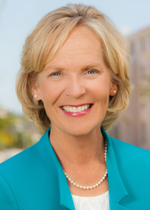 Who doesn’t want to take a peek into the future?
Who doesn’t want to take a peek into the future?
Your department leaders and I recently got a glimpse, and I want to share with you a bit of what we saw. We heard from Mary O’Hara-Devereaux, who does forecasting for dozens of corporations and nonprofits.
She’s not magic, creating some crystal clear vision of the world to come. But drawing on her experience and using some scientific analysis, she’s able to paint some good outlines.
It’s not an idle daydream exercise. This is meant to get us thinking long and hard about how we prepare the County for the years ahead. And while Mary gave us the lay of the land, it will be up to us how we navigate it.
She covered a lot of ground, so I’m picking out a couple themes of particular interest for us at the County.
The first is who our customers will be. In a word: older. You may have heard of the “Silver Tsunami” bearing down on us. But hearing more details on the numbers was a wake-up call to just how dramatic this will be. By 2035, more people will be over 65 than under 21. Our fastest growing age group now is people over 85 years old.
Think about that. 85 used to be quite a milestone. Now it’s just the entry to an age bracket that will include people routinely hitting 100.
 U.S. Census Bureau numbers for U.S. population.
U.S. Census Bureau numbers for U.S. population.
The demands that will make on a County department like Aging and Independence Services are obvious. But it goes beyond that.
Do we have enough hiking trails or exercise equipment suitable for these advanced age people? Will our libraries have materials in the form older adults want?
Homes will need more accessibility features. How will that affect our code compliance work?
We want our customers to go online for services whenever possible. Are our websites and apps easy to read and use for all ages?
What we’ll also see is “healthy longevity.” Not just more years, but more of higher quality. So much so, that Mary sees the phase from 60 to 80 years old becoming “second middle age.” They will want to grow and have active, engaged – thriving – lives.
What do we need in place to make that possible? How can we harness their collective experience and direct it back to helping us achieve our goals?
Having so many years of life is going to totally rewrite the rules of personal financial planning. The first millennials will be eligible for Social Security in about 30 years. That means about 2047 – not that far away when we’re taking the long view – that already strained system will need to support boomers, Gen Xers and millennials at the same time.
While we will have more people aging well, not everyone will be so lucky. The number of seniors having some kind of difficulty or another with self-care will increase dramatically. Meeting their needs for things like transportation will be an immense challenge. It’s difficult already for adult children to care for aging parents. What happens when those children are aging themselves? How will adults cope if they’re taking care of parents and grandparents?
A couple more notes about this population. We’re about at the point now where more seniors are single than married. That trend is going to continue. And women will not only keep outliving men but widen that gap.
 U.S. Census BureauAre you ready to serve 95-year-old single women? Because that’s going to be a significant demographic group for us to consider. Puts a new spin on “All the Single Ladies.”
U.S. Census BureauAre you ready to serve 95-year-old single women? Because that’s going to be a significant demographic group for us to consider. Puts a new spin on “All the Single Ladies.”
Meanwhile, we can’t ignore the other end of the age spectrum. Sorry millennials, but you’re so last decade. Generation Z is now emerging into the workforce. While we need to be wary of any sweeping generalization of generations, trend-watchers see Gen Z as distrustful of authority, but also team players. As a government, we’re the definition of authority. How do we gain the trust of these young people, seize on that desire to work as a team, and make them partners in our vision?
A big part of our challenge is figuring not just how we address one of these groups or another, but how we address all of them. That entire spectrum is stretching. How do we make a service available to someone who has never used a computer and someone who lives by Snapchat?
I’ll use that question as a bridge to the next theme I want to touch on: technology. Specifically, artificial intelligence. We’re just at the dawn of how this will change our lives.
We’re big on partnerships here at the County. Now that’s going to include collaboration between humans and machines.
What will self-driving cars mean for County roads? Or for the deputies who patrol them?
“Hey, Alexa, explain how I adopt a child.” How do we build the system that turns that into a conversation – and have that result in a new family?
AI’s ability to look across all the data we gather, analyze it, reveal connections and make predictions will be transformative. It will come into play for everything from tracking communicable diseases to fraud detection to assessing disaster risk – and on and on.
But as Mary pointed out, technology doesn’t drive change. Human choices make change. As the power of AI enhances our work, we’ll need to focus more on the human side of the equation. The challenge that Mary calls “defining our human comparative advantage.”
That means we need to place a premium on our employees having qualities like empathy. Cross-generational, cross-cultural. Cross-anything outside our own personal experience.
We are on the right track. Know Our Customers is one of the main steps in the Customer Experience Initiative. Empathy is the essence of being trauma-informed. Our Diversity & Inclusion Initiative is designed to build understanding of one another.
Empathy is really just a form of imagination. That takes us to Mary’s final point.
Our biggest risk going forward: a failure of imagination.
Luckily – well, by design really – we’ve long stressed the importance of innovation at the County. It’s part of our culture, and I’m in awe of the great ideas I constantly see gush forth from this organization. We’ll need to imagine and innovate like never before. But even if the future is uncertain, my experience here has given me great certainty in our ability to meet the challenges ahead. With that kind of confidence, I’m excited to head into the future. See you there!
Recent InTouch columns
Stepping Up Our Fight Against Homelessness
New Year, New Changes
Firm Values in a Season of Change
All InTouch columns




